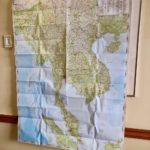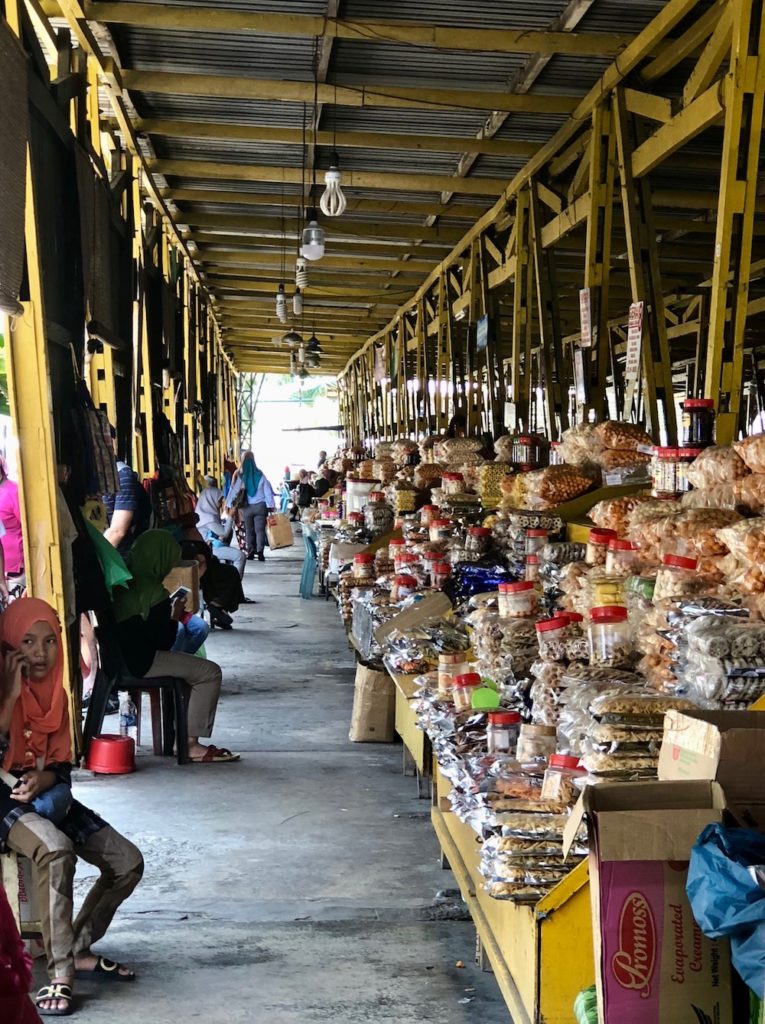
Vietnam and Malaysia: Chaotic Scooter Culture, Vibrant Markets, and Rickety River Bridges
Let it be known that we did not die when we rode, perched in the front baskets of trishaw bicycles, through the middle – and I mean the middle – of Central Saigon traffic. I thought

I might be a goner when my driver stuck his bike – I mean he stuck ME, since I was on the front of the bike – into the middle of an intersection, where waves of scooters revved, impatiently waiting to zoom across from three different directions. I closed my eyes and braced for impact, but they must have stopped for me, or I wouldn’t be writing

this now, would I?
Millions of small scooters zoom everywhere in Saigon (now officially known as Ho Chi Minh City), loaded with anything you can imagine. My favorite was one guy who’d affixed two large office chairs to his scooter – the whole mess of scooter-man-chairs skillfully zipped and swayed through the chaotic traffic, no sweat. The next day as we waited by a scenic Nha Trang river bridge, I startled when several scooters appeared behind me, then clattered over the very narrow wood slat bridge, one with a huge load of boxes piled to the heavens, strapped to the driver’s back.
So the scooters definitely had out attention, but there’s been so much more we’ve seen in the last few days it’s difficult to know where to start. So let’s back up a bit:
MALAYSIA

Since last I wrote, we started below the bottom of the map, in Kota Kinabalu,

Malaysia,which provided this sunrise view over Kinabalu Mountain. Today, we are near the top right corner of our map (we redecorated the cabin, and Oscar our attendant seems fine with it). We took a so-so tour of Kota Kinabalu, where the culture shock of the local market introduced us to Southeast Asian shopping.
Whoa! Now that we’ve navigated a total of four markets, here are the ‘rules’ we’ve learned:
Rule #1: Make sure you know how to say ‘no’ – a raised hand, rotated in a half moon, like a fast version of a princess wave. I forgot this, and wished I reread my notes before we shopped because if

you don’t communicate a solid ‘no’ right off the bat, not good. We heard ‘what you want?” and had our sleeves yanked on, fans shoved in our faces, repeatedly. They spot ‘tourist’ a mile off and that means money, so prepare to be hounded, and hounded we were.
Rule #2: Be prepared to bargain, but back to our rich tourist facades: Bargaining is harder because of what we look like. Our guide Hoi instructed us to get 25% off anyway, and I failed more than I succeeded on that one. My addendum to Rule #2: Don’t buy much (we didn’t) and remember you have to haul it home in your suitcase. Goods are cheap, comparatively, so the shoppers onboard love the markets (and knockoff anything abounds, if that’s your thing). But I spent more time wondering how people working in the market manage to make a living, and I do appreciate how ‘rich’ even the poorest Americans probably are, in comparison.
One other note, for the cooks out there: So many ingredients here for creating amazing meals – simply wow. No wonder Southeast Asian cuisine ranks at the top of the world. Take Seattle’s Pike Place Market food stall area and multiply it many times to equal the Central Market in Kota Kinabalu – it goes on forever, and is filled with amazing foodstuffs, spices,

and cooking wares. All manner of life resides inside the vast warren of stalls, where people sleep, eat, socialize, and live (it sure looked like to me). And I found this lovely black cat living there as well (cat score!).
HO CHI MINH CITY, VIETNAM (SAIGON)
Here is where we met scooter culture, as well as Vietnamese history including the Vietnam War, which seems to be fast fading from cultural memory as the modern city rises in prosperity. For me, this picture best captures how Saigon has changed. Remember that famous picture of the last helicopter out of Saigon in 1975, taking

off from a rooftop, with a line of desperate people still trying to get on it?
Well, here’s that rooftop today, the top of a decaying old building surrounded by rising skyscrapers. In 1975, this was the highest building in central Saigon, but no more. Even the War Remnants Museum (called the War Crimes Museum by the communist government until the end of the US embargo), seems tattered around the edges, more for the tourists than for Saigon’s young scooter entrepreneurs.
Later, I plan to write a separate history post on what we learned at the War Remnants Museum, when I have more time to ponder its impact. While it’s overtly designed as propaganda directed primarily at Americans, it still packs a punch and raises sobering questions about war and its aftermath that should never be forgotten. Padre, especially, remembers, since he served alternative service as a conscientious objector and the war changed the direction of his life significantly.
NHA TRANG, VIETNAM
Nha Trang served as a bit of a ‘vacation’ spot for US GIs during the war, due to its vast

golden beachfront and party nightlife. It’s still that, but we ventured a bit outside the city for a visit to a Buddhist orphanage. We felt like voyeurs as we toured through working Buddhist temples (In Saigon also) a communal meal, and an orphanage school in session. The Vietnamese don’t seem to mind, though, or they are so used to tourists traipsing through the middle of their lives that they just don’t notice anymore.
I thank them for letting us witness Buddhist rituals such as burning incense in honor of loved ones, chanting in unison, and sharing a meal (still chanting), rituals that seem to focus primarily on love and peace (except for the God of Hell; you don’t want to go there).
Our small tour group was made up of Australian teachers and their children – and us, of course. We became grandma and grandpa, in fact – our tour guide thought we were the matriarch/patriarch of this wonderful family group, until the very end of the tour. (Hoi referred to me as ‘mom’ the whole day and I never corrected him.) Enjoyed watching ‘our’ kids tour the orphanage, as their parents explained how the orphanage system worked and reinforced the concept of haves and have-nots. Teachers are simply the best – even though their children may get tired of being ‘taught’ all the time (right, all our grownup kids? It was good for you, truly….).

Next came our riverboat cruise and a riverside lunch, but not before the skipper repaired


the rickety steps we needed to traverse to get to the boat. Turns out one step was broken, so he pounded two nails in, and just like new – we’re good to go. Oh dear. This ride would never pass safety certification in the States.
The cruise down the river reminded me of the Vietnam of newsreels and films, minus the bombs and bullets – the brilliant green rice patties, the forest green jungle tangle,
the blue sky and the far off hills. (I did think of how it must have been like 40+ years ago, navigating this very river, though. Probably terrifying). And none of the children fell off the bow where they tempted fate frequently, much to their parents’ horror.
After our visit to the tallest Buddha I’ve ever seen (I imagine that in Thailand we’ll see many more), we finished with a visit to a weaving ‘factory’ (two industrious

Vietnamese women, working at a loom), and one more market visit before returning to our

home-away-from-home anchored in the harbor. Tomorrow we’re headed to Hong Kong, a city I’ve dreamed of visiting, and then on to Japan. I’ll have to change the wall map to the one of Japan tomorrow night, so we are making progress! Still not bored, still not avoiding all the delicious food, and making lots of new cruise friends, the best part of travel by far (and I found a Saigon kitty – cat score #2!). Thanks for following along.


